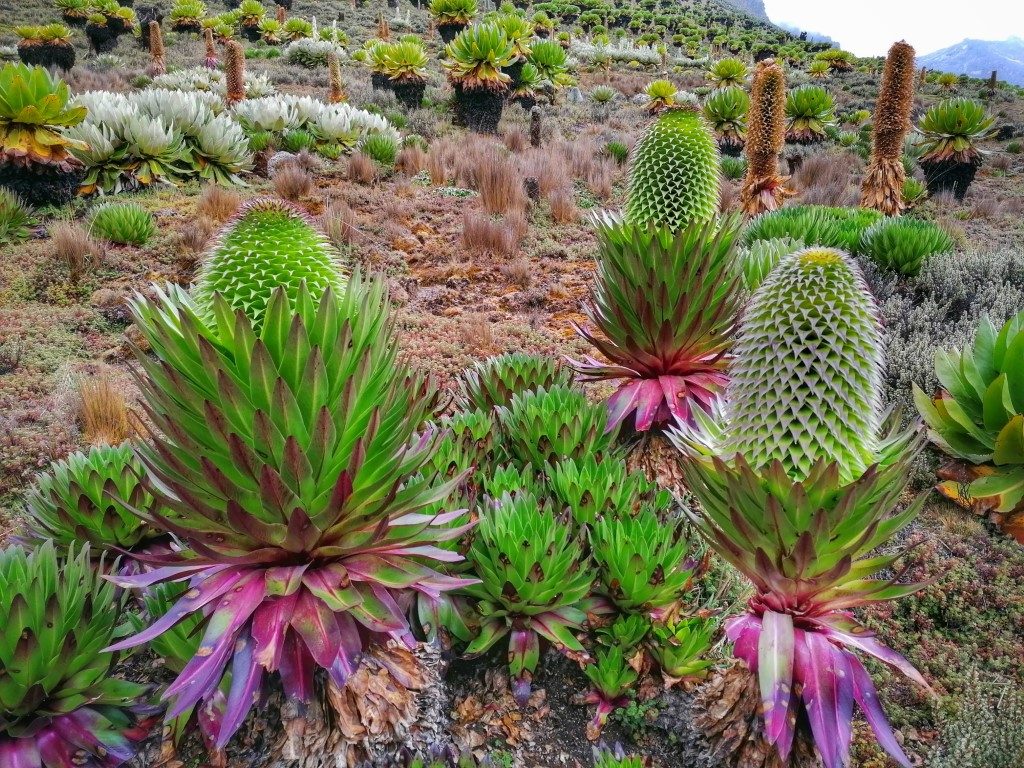
Mount Kenya Vegetation
Mount Kenya is home to a diverse range of vegetation, which changes as you ascend to higher elevations. With Ahambi Tours our guide will take you through the different types of vegetation found at different elevations.
The 5 Elevation Zone at Mount Kenya
1.The Montane forest zone
Is the lowest vegetation zone on Mount Kenya, located below 2,500 meters. It is characterized by tall trees such as camphor, olive, cedar and many more, and is home to a variety of wildlife such as elephants, buffalos, and monkeys.
The Montane forest zone is also known for its rich and diverse plant life, including ferns, orchids, and various species of mosses and lichens. This zone is particularly lush and humid, with an average annual rainfall of around 2,500 mm.
The Montane forest zone is an important source of water for the surrounding areas, with several rivers and streams flowing through it. It is also an important habitat for several species of birds, including the Hartlaub’s turaco, the mountain yellow warbler, and the African crowned eagle.
This zone is a popular destination for hikers and nature enthusiasts, with several trails and paths winding through the forest. The zone is easily accessible even with a 4WD Vehicles.
2.The Bamboo zone
Is one of the vegetation zones found on Mount Kenya, located between 2,500 and 3,000 meters above sea level. It is characterized by dense thickets of bamboo and is an important habitat for several species of wildlife, including elephants, buffalos, and several species of birds.
The bamboo thickets in this zone provide a sheltered environment for many species of wildlife, including monkeys and small mammals such as bushbuck and duiker.
The Bamboo zone is also home to several species of birds, including the Abyssinian catbird, the African crowned eagle, and the white-starred robin. The bamboo provides an important food source and nesting habitat for many of these bird species.
Hiking through the Bamboo zone can be challenging, as the thickets can be dense and the terrain can be steep and rocky depending with the route that one is using. However, it offers a unique and stunning landscape, with the tall and slender bamboo stalks towering above and creating a serene and tranquil atmosphere.
3.The Heather zone
Is one of the vegetation zones found on Mount Kenya, located between 3,000 and 3,500 meters above sea level. It is characterized by heath and moorland vegetation, with a wide range of plant species adapted to the harsh and rocky environment
The Heather zone is known for its unique and colorful plant life, including giant heathers, proteas, and several species of lobelia. These plants have adapted to the high-altitude environment and can withstand the strong winds and cold temperatures that are common in this zone.
The Heather zone is also home to several species of wildlife, including hyrax, bushbuck, and several species of birds such as the olive pigeon and the mountain buzzard. The hyrax, in particular, are commonly seen sunning themselves on the rocks and basking in the warm sun.
Hiking through the Heather zone can be challenging, as the terrain can be steep and rocky, and the weather can be unpredictable. However, it offers a stunning and unique landscape, with panoramic views of the surrounding mountains and valleys.
4.The Afro-alpine zone
Is one of the five vegetation zones found on Mount Kenya and is located above 3,500 meters. It is a unique and fragile ecosystem, characterized by sparse vegetation, including giant lobelias and other unique plant species.
The Afro-alpine zone is also known for its rocky terrain and cold temperatures, with average temperatures ranging between -5°C to 10°C. This zone experiences frequent cloud cover and mist, which create a unique and ethereal landscape.
The giant lobelia, is one of the most iconic plant species found in the Afro-alpine zone. These towering plants can reach heights of up to 15 meters and are adapted to the harsh conditions of the high-altitude environment.
The Afro-alpine zone is also home to several species of birds and small mammals, such as rock hyrax and mountain goats. The Verreaux’s eagle, the African black duck, and the mountain chat are some of the bird species that can be found in this zone.
The Afro-alpine zone is a popular destination for hikers and climbers who are looking for a challenging and rewarding experience. It offers stunning panoramic views of the surrounding landscape.
5.The Nival zone
Is the highest vegetation zone found on Mount Kenya, located above 4,500 meters above sea level. This zone is characterized by bare and rocky terrain, with very little vegetation due to the harsh and extreme conditions.
The Nival zone is known for its cold temperatures and strong winds, with average temperatures ranging between -10°C to 5°C. It is also frequently covered in snow and ice, which creates a stunning and otherworldly landscape.
Despite the harsh conditions, the Nival zone is home to several species of wildlife, including mountain hyrax, rock hyrax, and several species of birds such as the lammergeier and the Verreaux’s eagle. These animals have adapted to the extreme environment, and are able to survive in the harsh conditions of the high-altitude environment.
Hiking through the Nival zone can be extremely challenging and requires specialized equipment and experience due to the harsh and unpredictable conditions. However, it offers a unique and stunning landscape, with breathtaking views of the surrounding peaks and valleys.
The Nival zone is also an important source of water for the surrounding areas, with several rivers and streams flowing from the melting glaciers and snowfields.
Overall, the vegetation on Mount Kenya is diverse and beautiful, providing a unique and breathtaking landscape for climbers and visitors alike. At Ahambi Tours we make the experience even more memorable by offering you topnotch services.
